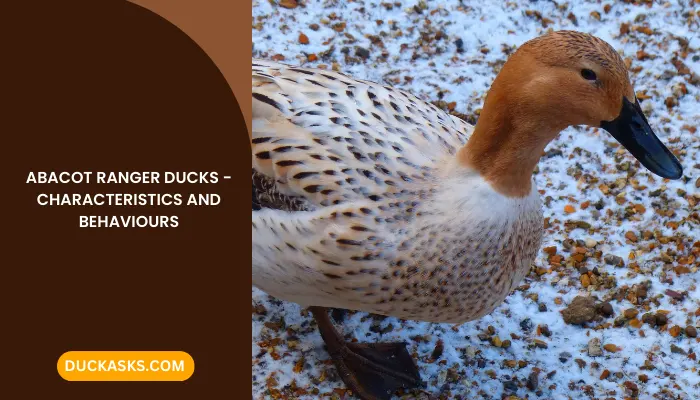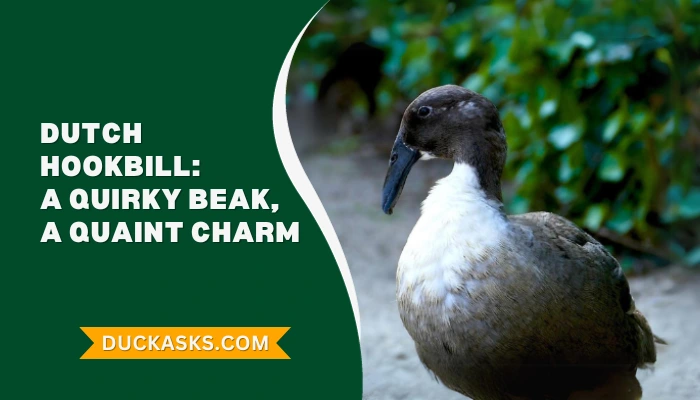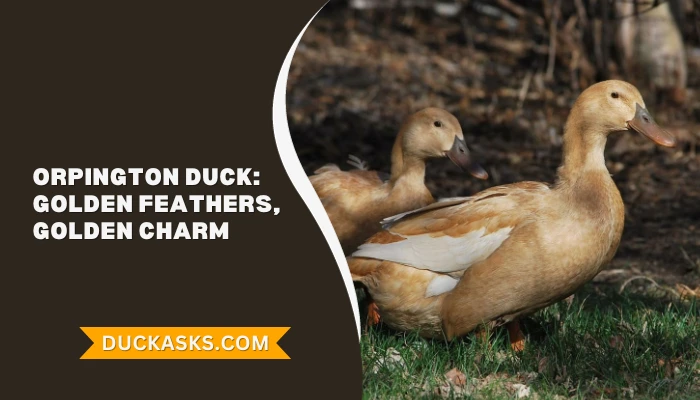Alabio Duck: Behavior, Habitat And More
Prepare to discover the wonderful yet underappreciated Alabio Ducks, a hidden jewel in the world of ducks.
These extraordinary birds stand out as true gastronomic marvels in a sea of quackers. Alabio Ducks are the cream of the quacker crop and are distinguished by great egg production and tender, flavorful flesh. The fact that these ducks are a gourmet’s pleasure and provide a delicious and adaptable dining experience is a well-kept secret.
But hold on to your hats, folks, because these brave wonders are more than just eye-catching. Despite their outstanding features, Alabio Ducks are still relatively unknown in the farming industry.
Here, we’ll go deeply into the Alabio Ducks universe, from learning about their egg-cellent secrets, delectable flavors, and tips for raising these wonders, to learning about their behavior, breeding habits, appearance, and advantages.
Get ready to be delighted because Alabio Ducks offers a quack-a-doodle-doo of flavor and profitability that you won’t want to miss!
History Of The Alabio Duck Breed
Itik Alabio, the native name for alabio ducks in Indonesia, has a fascinating history. These quacktastic ducks, which are native to the beautiful Kabupaten Hulu Sungai Utara district of Kalimantan, Indonesia, are the offspring of a crossbreeding experiment conducted by none other than the renowned scientist and veterinarian Saleh Puspo.
Saleh gave them the appropriate name “Alabio,” which was taken from the neighborhood they were raised in.

The breeding procedure featured a feathery encounter between the indigenous Indonesian ducks and the regal Pekin duck, producing a distinctive blend of traits that properly distinguish Alabio ducks.
This lovely crossbreed blends the unique characteristics of the Pekin duck with the charm of the local population to produce a quacking fusion that has captured the hearts of duck lovers all around the world.
Speaking of conquering hearts, Alabio ducks are now well-known throughout their native country. With their brilliant plumage, social quacktivism, and outstanding agility grabbing the nation’s attention, they are the rock stars of the duck world in Indonesia. In fact, in 2006, the number of Alabio ducks boldly waddling its way through the 13 regencies of South Kalimantan reached a record-breaking 3,487,002.
Therefore, keep an eye out for these feathered celebs if you ever find yourself in the vibrant country of Indonesia. The Alabio ducks’ distinctive fusion of regional tradition and Pekin duck panache will enchant you without a doubt.
Looking for more article about ducks breed:
Scientific Name Table
| Kingdom | Phylum | Class | Order | Family | Genus | Species | Subspecies |
|---|---|---|---|---|---|---|---|
| Animalia | Chordata | Aves | Anseriformes | Anatidae | Anas | Platyrhynchos | Domesticus |
General Characteristics
Here we will unravel the common attributes of Alabio ducks and Alabio duck drakes.
Alabio Ducks
Domestic ducks of the Alabio breed, often referred to as Itik Alabio, have its roots in the Alabio region of the Philippines. They are prized greatly for their versatility, production, and distinctive qualities. The general traits of Alabio ducks are as follows:
Dimensions and Appearance: Alabio ducks are medium-sized waterfowl that typically weigh between 1.0 and 1.5 kilograms for females and 1.5 to 2.0 kilograms for males in the form of drakes. Their heads are rounded, their necks are short, and their bodies are compact. Alabio ducks have a variety of colors in their plumage, including brown, black, and white tones.
Adaptability: These ducks are hardy and versatile because they are well-suited to varied climatic situations. They may survive in lowland areas, marshes, rice fields, and home ponds as well as urban and rural settings.
Egg Production: They are well-known for their exceptional egg-laying ability. The ducks can lay 180 to 220 eggs annually, starting to lay eggs at about five to six months of age. The eggs normally range in size from tiny to medium and have a light bluish or green tinge.
Meat Quality: In case you didn’t know Alabio ducks are prized for their meat in addition to their ability to lay eggs. They have tasty flesh with a soft texture. Their flesh is used in numerous culinary preparations and is highly prized in the neighborhood market.
Foraging Abilities: Alabio ducks are outstanding foragers with a strong instinct to look for food both on land and in the water. They consume small crustaceans, snails, worms, insects, aquatic plants, and insects. Their foraging habits add to their overall resiliency and independence.
Disease Resistance: These feathery beauties have demonstrated a high degree of resistance to typical duck diseases, such as avian influenza. Due to their resistance, they are more likely to survive and require fewer intensive medical procedures.
Alabio Duck Drakes
Male ducks or alabio duck drakes have their own distinctive characteristics. Here are some specific features of alabio duck drakes:

Size and Weight: When compared to female ducks, alabio duck drakes are a little bit bigger and heavier. They weigh between 1.5 and 2.0 kg on average.
Feather Coloration: Alabio duck drakes’ plumage frequently features striking colors and patterns. On their heads, necks, and wings, they can have a mix of iridescent green, blue, and black feathers.
Breeding Behavior: Just like other ducks, Alabio duck drakes perform courtship rituals to entice the female ducks during the breeding season. To assert their authority and capture the attention of the females, they engage in characteristic activities such head-bobbing, wing-flapping, and vocalization.
Voice: Compared to female duck vocalizations, the calls of alabio duck drakes are louder and deeper. They communicate using vocalizations, which can range in pitch and intensity.
Alabio Duck Temperament And Behavior
Alabio ducks are fascinating and sought-after domestic waterfowl due to their temperament and character. These ducks are renowned for their placidity, and engagement in social activity.

Let us put more emphasis on this matter in the upcoming segments.
Rarely Fly
Alabio ducks are renowned for having a limited capacity for flight. Alabio ducks rarely fly, in contrast to some other varieties. They prefer to spend the majority of their time hunting for food and doing other activities on the ground or in the water.
They are ideal for confinement in small spaces or backyard ponds due to their decreased ability to fly. However, it’s crucial to make sure that they have enough space in their home to walk around comfortably.
Forager
These ducks that forage has a high inherent propensity for doing so. By looking for aquatic plants, insects, snails, worms, and small crustaceans, they are adept at seeking their own food. In numerous respects, this foraging behavior is advantageous.
First of all, it aids in completing their diet and lowering feed expenses, especially when they have access to open spaces and natural water sources. Second, it enables people to engage in healthy activities and natural behaviors that improve their general health and wellbeing.
To ensure that their nutritional demands are addressed, a balanced meal must be given in addition to their foraging efforts.
Extra Space
Even though Alabio ducks can adapt to a range of living situations, giving them more room is good for their general health and behavior. They flourish in settings where they are free to wander about and behave naturally.
They will be able to express their natural inclinations, such swimming, foraging, and socializing, if they are given enough room in their enclosure or access to a pond or bigger outside area.
The ducks may develop their own territories and maintain a comfortable distance from one another, which reduces stress and potential hostility among them.
Alabio Ducks Breed Profile
These ducks are primarily raised for their eggs and are well-suited for backyard or small-scale farming. Here we have curated a table incorporating all the nitty-gritty of duck breed profile and more.
| Information | Alabio Ducks |
|---|---|
| Average Egg Yield | 200 eggs per year |
| Ease of Keeping | Easy |
| Common Uses | Egg production, meat |
| Egg Color | Light to medium brown |
| Origin | Indonesia |
| Weight of Drake | 1.8-2.00 kg |
| Weight of Duck | 1.6-1.8 kg |
| Classification | Anas platyrhynchos domesticus |
Alabio Duck Eggs
Here’s a table discussing “breeding hints” and “british Bloodlines” for alabio duck eggs. Note that all the information provided below are allocated from standard Data.
| Alabio Duck Eggs | Breeding Hints | British Bloodlines |
|---|---|---|
| Breeding Season | March to August | January to December |
| Ideal Temperature | 24-30°C | 15-25°C |
| Nesting Behavior | Provide nesting boxes | Natural nest formation |
| Incubation Period | 28-32 days | 26-30 days |
| Brooding Method | Mother or artificial | Mother or artificial |
| Feeding Tips | High-quality duck feed | Balanced diet with grains |
| Health Considerations | Regular vaccinations | Regular vet check-ups |
| Bloodline Origin | Indonesia | Imported from Britain |
| Breeding Objectives | High egg production | Maintaining pedigree |
| Egg Characteristics | Medium to large size | Rich and flavorful |
The Meat of Alabio Duck: A Delightful Gastronomic Adventure
Unravel the wonders of Alabio duck meat as we take you on an enthralling culinary adventure. This Indonesian treat has outstanding qualities, a delicious flavor, and a remarkable nutritional value.
Distinctive Attributes: Alabio duck meat is distinguished by its perfectly balanced lean and fatty portions and marbling. Due to its natural diet of aquatic vegetation, the meat has an earthy sweetness that gives it a distinct and memorable flavor.
Taste Sensation: Its flesh is a sensual joy to indulge in. A kaleidoscope of flavors, from subtle gamey undertones to traces of herbs and spices, are revealed in each delectable bite. Its juiciness and softness enhance both conventional and cutting-edge cuisines.
Nutritional value: These duck meat have an excellent nutritional value. It is a good source of iron, zinc, B vitamins, vital amino acids, and protein. It adds to a nutritious and well-balanced diet because it contains heart-healthy monounsaturated fats.
The Popularity of Alabio Ducks
Due to their exceptional meat, Alabio ducks have become increasingly popular. Alabio duck flesh is renowned for its mouthwatering flavor and distinctive qualities, and it has won over the culinary world.
Alabio meat offers an unmatched flavor experience thanks to its marbling, ideal ratio of lean to fatty sections, and a hint of sweetness from their natural diet.

Both conventional and avant-garde meals benefit from its succulence and softness. Its flesh is a powerful source of protein, vital amino acids, iron, zinc, and B vitamins. It also packs a nutritious punch.
This culinary gem continues to enchant food fans and is a sought-after option for those looking for an outstanding dining experience because to its extraordinary flavor and impressive nutritional profile.
Alabio duck flesh dominates both traditional dishes and inventive inventions, demonstrating why it has gained popularity among sophisticated palates all over the world.
The Benefits of Raising Alabio Ducks
Here we will uncover the amazing advantages of rearing Alabio ducks, a feathery marvel that offers amiable vibes, wholesome returns, and an abundance of eggs. These adorable animals flourish with little work, effortlessly turning feed into meat and eggs while captivating farmers with their placid demeanor.

Alabio ducks provide a sustainable alternative for farming success with their aptitude for foraging and eco-friendly touch. Prepare to reap a swarm of rewards as these alluring ducks contribute feathers of wealth to your agricultural operations, from financial viability to lush fields.
- Alabio ducks are well recognized for being docile and amiable, which makes them simple to manage and rear.
- Due to their independence and low input requirements, they support a healthy and sustainable farming system.
- Alabio ducks are prolific egg layers and offer a steady supply of eggs for eating or for use in breeding.
- They can turn feed into meat and eggs more effectively than other poultry because they have high feed conversion rates.
- As Alabio ducks need less feed and space than larger livestock animals, raising them might be financially advantageous.
- In integrated farming systems, their excrement acts as a natural fertilizer to improve the soil and encourage crop growth.
- Alabio ducks have the ability to diversify farmers’ sources of revenue because both domestic and foreign markets are interested in their meat and eggs.
- These ducks are visually appealing with their vibrant plumage, adding beauty to farm landscapes.
Challenges of Raising Alabio Ducks
Like any other livestock, raising alabio ducks come with its own set of challenges. Here are some common intricacies associated with raising these feathery folks.

Habitat and Housing
Raising Alabio ducks requires providing them with an appropriate habitat and housing. Ducks need enough room, good ventilation, and safety from predators. Construction and upkeep of suitable housing buildings can be difficult, especially if your flock is large.
Feeding and Nutrition
They need a balanced diet to keep healthy and productive, thus feeding and nutrition are important. It might be difficult to provide the right food and ensure that everyone has access to clean water, especially in bad weather or in places where there isn’t much access to high-quality feed.
Disease Control
Ducks are prone to a number of illnesses and infections. Disease management and prevention depend on practicing excellent hygiene, receiving routine immunizations, and putting biosecurity measures in place. Given that ducks prefer to conceal symptoms until they are gravely ill, diagnosing and treating illnesses in them can be difficult.
Water Management
Ducks are waterfowl, and as such, they require access to clean water for drinking, bathing, and swimming. It can be difficult to manage water sources and ensure cleanliness, particularly in large-scale activities or during dry seasons when water shortage is an issue.
Predators and Pest Control
Ducks are susceptible to being eaten by predatory creatures such as dogs, foxes, raccoons, and birds of prey. Implementing suitable fencing, securing housing structures, and taking deterrent actions are all necessary for protecting ducks from predators. It’s crucial to manage pests like insects and parasites that might harm the health of the ducks.
Breeding and Reproduction
It might be difficult to ensure successful breeding and reproduction, particularly if you want to preserve or enhance the genetic traits of the breed. It might be difficult to keep track of mating, manage nests, and create ideal conditions for eggs to hatch.
Market Demand
It’s irksome to gauge market demand and identify potential customers for Alabio ducks and their products. It could take time and networking to create a marketing plan and build a trustworthy sales channel for ducks and their byproducts.
Financial Management
Managing the finances of a duck farming operation can be complicated, as it is with any agricultural endeavor. Careful planning and monitoring are necessary to maintain a balance between the expenses for feed, housing, medical care, and other inputs and the revenue from duck sales.
How Does a Alabio Duck Behave?
The gregarious avian delight, with its stunning black plumage and endearing personality, captures the eye.
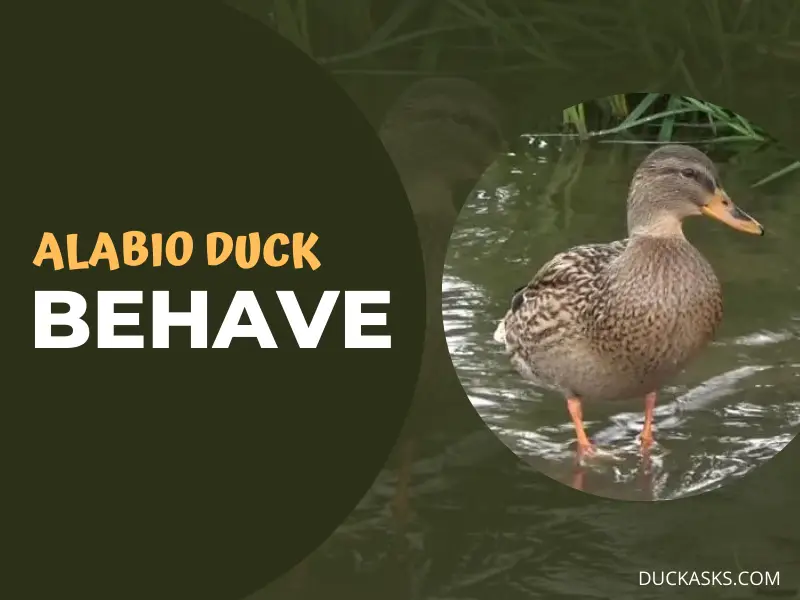
These Indonesian locals, who have a propensity for gathering in small groups, exhibit a complex social structure headed by a dominant male and female. In the following segments, let’s investigate how alabio ducks act.
Social Behavior of Alabio Ducks
These wagglers exhibit gregarious behavior and frequently group together in small flocks. They love to reside in wetlands like ponds, rice paddies, and swamps. They create a social structure with a dominating male and female inside the flock.
Mating Behavior (Breeding)
Male Alabio ducks participate in courtship displays to entice females during the breeding season, which normally lasts from November to March. These gestures include vocalizations, neck extending, and head bobbing. A number of females are mated with the dominant male, who also creates his territory.
Feeding Behavior
They have a herbivorous diet that consists mostly of water plants, grasses, seeds, and insects. Alabio ducks use their specialized bill to filter tiny organisms and detritus from the water as part of their filter-feeding mechanism. It frequently bobs up and down as it graze in shallow water.
Taming Behavior
These ducks can be domesticated with the right handling and care. They may become habituated to human presence and exhibit some degree of tameness if they are reared by people from an early age. Individual disposition can vary, thus not every duck will be able to totally tame. Alabio ducks can be domesticated with regular, gentle encounters and good reinforcement.
Like many other duck breeds, Alabio ducks enjoy a varied diet that includes both organic and processed meals. Let’s find out what these cute ducks like to eat.
What Does a Alabio Duck Eat?
Like many other duck breeds, Alabio ducks have a diverse diet that consists of both natural and commercial foods. Let’s explore what these delightful ducks enjoy munching on.
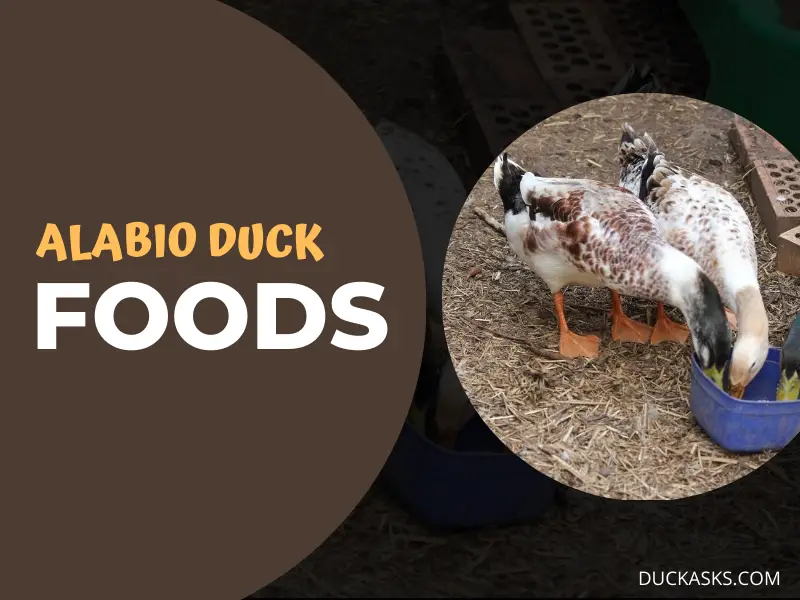
Organic Food
Insects: Alabio ducks naturally prefer to hunt and eat insects, which are a crucial component of their diet. They eagerly consume insects like grasshoppers, beetles, and crickets for food.
Bugs: In addition to insects, the Alabio duck also consumes worms and spiders as part of its natural diet. The ducks get a lot of protein from these tiny creatures.
Veggies: Alabio ducks enjoy consuming a range of veggies. They joyfully eat leafy greens like lettuce, spinach, and kale because they provide fiber and other nutrients.
Fruits: Alabio ducks enjoy eating fruits, especially berries, melons, and thinly sliced apples. These fruits provide additional vitamins and minerals in addition to providing a sweet and energizing aspect to their diet.
Commercial Food: In addition to their natural food sources, Alabio ducks can also gain advantages from commercial feeds that have been properly designed. These feeds are created to offer a nutritious diet that is balanced and satisfies the unique nutritional needs of ducks.
A combination of grains, seeds, and pellets is frequently found in commercial duck feeds, ensuring that the birds eat a balanced diet. These meals frequently include important vitamins, minerals, and protein sources to support the health and growth of Alabio ducks.
Now is there any special food for Alabio ducks? Well while there may not be a singular “special” food exclusively for these waggles, guaranteeing a well-rounded and nutrition-packed diet that includes natural and commercial foods will help keep these delightful waterfowls healthy and thriving.
Which Type of Habitat is the Best for Alabio Ducks?
When it comes to habitats, these feathered companions each have different tastes. Let me walk you through the greatest kind of environment to build for these wacky critters if you want to make a paradise for them.
First and foremost, wetlands are their greatest favorite place to be. They are the Michael Phelps of the duck world, so creating a habitat that resembles a wetland is essential. Imagine it as their very own opulent spa getaway.
Since these ducks live and breathe water, you must provide them with a calm marsh or a small pond. Make sure it’s deep enough for them to swim, splash, and play in it once you fill it with clean water. For a touch of natural beauty and a delectable snack, don’t forget to include some water plants as well!
Like when you indulge in a soothing bath, Alabio Ducks also value some privacy. So, encircle their oasis of wetlands with some high-growing grasses, bushes, and trees. These will offer them cover from the sun during the sweltering summers and a comfortable hiding place when they want to retreat from curious eyes.
Where To Buy Alabio Ducks?
So where can you find these feathered friends? Let’s see what the options are!
Local Farms
Well, investigate the local farms and hatcheries first. Connecting with farmers helps the community while allowing you to observe how these adorable ducks are reared. The countryside is full of hidden gems.

Designated websites
Do you prefer the ease of online shopping? Explore the enormous internet of websites dedicated to poultry and waterfowl. With just a few clicks, a quackery wide range of alternatives will be revealed. For peace of mind that you’re getting the real deal, don’t forget to read customer reviews and check the seller’s reputation.
Agricultural Fairs
Keep a look out for agricultural fairs, poultry exhibits, or bird shows in your area for an exciting shopping experience. These gatherings of farmers, breeders, and fans provide a fun opportunity to get to know other duck lovers and locate potential Alabio companions.
Keep in mind to give utmost priority to the ducks you purchase. Focus on narrowing down the ethical and reliable supplies from the scammer ones. It’s crucial for the supplies to have an emphasis on moral breeding methods who will deliver healthy, loved and well-treated ducks.
Other Similar Ducks
If the allure of Alabio ducks has captured your attention, you’ll be happy to learn that there are more like duck breeds that you could enjoy! A few feathered companions we’d like to introduce to you are:
Pekin Ducks: Popular due to their plump bodies and pristine white feathers, pekin ducks are small and squat. They are excellent for producing meat and eggs and have a sociable nature.

Indian Runner Ducks: You may not know that Indian runner ducks have a peculiar upright position which make them appear extremely amusing.
These ducks are available in a variety of hues, including white, fawn, and chocolate, and are renowned for their remarkable egg-laying ability.
Khaki Campbell Ducks: Due to their exceptional laying prowess, Khaki Campbell ducks are a popular choice for egg production. They are appreciated for their bright and active personalities and have sleek khaki-colored plumage.
Muscovy Ducks: With their crimson, warty face features, muscovy ducks stand out from the crowd. They are a domestic breed with a variety of feather colors, and their lean, flavorful meat is well valued in the market.
Rouen Ducks: These ducks have stunning plumage with a blend of iridescent green and brown, like wild Mallards. They are valued for both their meat and eggs.
Conclusion
So, we have explored the fascinating world of Alabio Ducks, learning about their extraordinary traits, astonishing adaptation, and pleasant eccentricity. These quacking wonders have won our hearts with their distinctive feather designs and amazing foraging abilities.
Consider the amazing journey we’ve been on and the wonders these feathered friends offer to our world the next time you see an Alabio Duck waddling by. If you have any queries related to the topic, feel free to let us know!
Image Credits:
- www.roysfarm.com/alabio-duck/
- www.thehappychickencoop.com/ (Cheryl Howell)
- Canva.com/photos (Leung Cho Pan)




